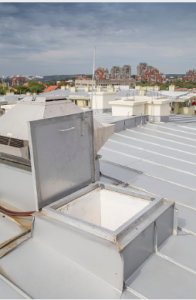If you need to gain access to the roof of a building or structure, you may need to install an access hatch. These hatches are classified as confined spaces, and as such, they must be designed, constructed, and used following the relevant Work Health and Safety Regulations. Part 4.3 of the regulations set out the requirements for those who have to ensure the health and safety of workers entering and exiting such areas. In particular, duty holders must ensure that all workers are trained and qualified for their tasks.
Roof access hatch
 This access hatches Adelaide provide a convenient and cost-effective way for roof workers to access the roof from the inside. The latching system is operated by compression springs in zinc-plated telescopic tubes. The hatch also features a wide flange that secures it to the roof deck. In addition, the latching mechanism features both an interior and exterior handle and provisions for padlocks.
This access hatches Adelaide provide a convenient and cost-effective way for roof workers to access the roof from the inside. The latching system is operated by compression springs in zinc-plated telescopic tubes. The hatch also features a wide flange that secures it to the roof deck. In addition, the latching mechanism features both an interior and exterior handle and provisions for padlocks.
Roof hatches are generally made of 14-gauge galvanized steel and are finished in a white powder coat finish. They come with 1” insulation, which can be upgraded to a higher R-Value if necessary. The hatches also feature a perimeter rubber gasket for leak protection. For added convenience, the lid opens and closes with a single-handed operation. Several models are available, and you can also choose a custom-sized model.
Roof access hatches are useful for removing larger equipment. They may have two doors or one small cover and must comply with safety regulations. For safety reasons, installing roof hatches that meet OSHA requirements is essential. These hatches must be installed on a flat roof with a maximum incline of 30 degrees to be compliant.
The location of a roof hatch is also important. It may not be convenient if it is too tall to be accessible from the bottom floor. A hatch six feet or less from the edge of a building must be equipped with a guard rail. Its pivoting joints should be lubricated to make opening and closing easier.
A roof access hatch is designed to protect people from falling from a roof. It is typically made of 14-gauge galvanized steel with a self-flashing base. The manufacturer of these hatches, Babcock-Davis, makes them in the United States. These hatches can also be customized to meet the needs of your specific building.
A roof hatch is a much safer way to access the roof than a traditional or exterior wall ladder. In addition to being safer, a roof hatch is more likely to prevent damage to the roof. Moreover, wall ladders require much more maintenance than a roof hatch, and many don’t meet building codes.
Types of roof access hatches
Using roof access hatches in building construction is necessary, but there are several precautions you should take before installing them. First, ensure that the hatches will not be hazardous to workers. OSHA has strict rules about the safety of workers in roofing jobs, including roof hatches. A fall from an open roof can be fatal. Fortunately, there are products available to ensure worker safety and compliance.
There are several different types of roof access hatches. Some are made of steel or aluminium. Others are made from polycarbonate and are made to let sunlight in. For high-security buildings, you may want to get a bulletproof hatch. In either case, ensure that the hatch has safety features, such as a latch that holds the door in the open position when used.
Another factor to consider when choosing a roof access hatch is the height and width. A smaller hatch may be too narrow for a ladder to climb, resulting in a risk of head-bumping accidents. A larger hatch will prevent these accidents. In addition, double-leaf hatches can have openings of up to 66 square feet.
The material of a roof hatch is another important factor. The choice of material is often based on the location of the building, cost, aesthetics, and maintenance. Aluminium roof hatches, for example, are generally more expensive than galvanized steel hatches but offer greater corrosion resistance, which is particularly important for coastal buildings. Copper and stainless-steel roof hatches are also good choices for historical buildings.
Roof access hatches are designed to provide easy and safe access to roof spaces. You can select from fire-rated or non-fire-rated options, each with pros and cons. Make sure you choose the right one for your project. If you aren’t sure what to purchase, consider these tips and guidelines.
Materials used for roof access hatches
The materials used for roof access hatches can make a large difference in the overall cost and appearance of a building. It would be best if you considered the corrosion resistance, aesthetics, and maintenance needs of your building before deciding on a particular material. For example, if you’re building in a coastal area, you may want to choose stainless steel or aluminium roof hatches. Alternatively, you may prefer a copper hatch to complement the aesthetics of the building’s historic district or heritage project. In any case, many options are available to meet the access requirements of any commercial building.
The purpose of your roof hatch will determine the type and size of your hatch. Single-cover hatches may be sufficient for a single person, while larger ones may be ideal for more frequent personnel access. However, if you’re looking for a secure roof hatch for equipment, you’ll need a double-cover model. Manufacturers of roof access hatches can create custom-designed roof access hatches to meet your exact specifications.